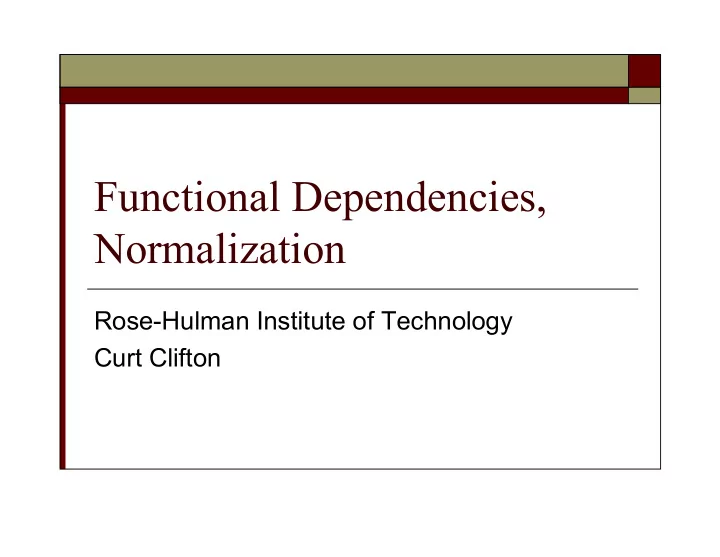

Functional Dependencies, Normalization Rose-Hulman Institute of Technology Curt Clifton
Or…
Fixing Broken Database Designs This material will almost certainly appear on Exam II next week.
Outline Functional Dependencies Keys Revisited Redundancy and Anomalies Normalization
Functional Dependencies (FD) Let X be a set of attributes of a relation R Let A be a single attribute of R X → A holds for R if: whenever two tuples of R agree on all the attributes of X, then they must also agree on the attribute A. We say X “uniquely determines” A in R
Example Customer(Name, Addr, SodaLiked, Manf, FavSoda), with name identifying a unique person Lots of redundancy here… Name Addr SodaLiked Manf FavSoda Janeway Voyager Pepsi PepsiCo Coke Janeway Voyager Sprite CocaCola Coke Spock Enterprise Pepsi PepsiCo Coke
FDs from Data Does Name → Addr? Name Addr SodaLiked Manf FavSoda Janeway Voyager Pepsi PepsiCo Coke Janeway Voyager Sprite CocaCola Coke Spock Enterprise Pepsi PepsiCo Coke
FDs from Data Does Name → Addr? Yes, since we assumed unique names Name Addr SodaLiked Manf FavSoda Janeway Voyager Pepsi PepsiCo Coke Janeway Voyager Sprite CocaCola Coke Spock Enterprise Pepsi PepsiCo Coke
FDs from Data Does Name → FavSoda? Name Addr SodaLiked Manf FavSoda Janeway Voyager Pepsi PepsiCo Coke Janeway Voyager Sprite CocaCola Coke Spock Enterprise Pepsi PepsiCo Coke
FDs from Data Does Name → FavSoda? Yes, we want just one favorite per person Name Addr SodaLiked Manf FavSoda Janeway Voyager Pepsi PepsiCo Coke Janeway Voyager Sprite CocaCola Coke Spock Enterprise Pepsi PepsiCo Coke
FDs from Data Does SodaLiked → Manf? Name Addr SodaLiked Manf FavSoda Janeway Voyager Pepsi PepsiCo Coke Janeway Voyager Sprite CocaCola Coke Spock Enterprise Pepsi PepsiCo Coke
FDs from Data Does SodaLiked → Manf? Yes, since each soda has just one manf. Name Addr SodaLiked Manf FavSoda Janeway Voyager Pepsi PepsiCo Coke Janeway Voyager Sprite CocaCola Coke Spock Enterprise Pepsi PepsiCo Coke
FDs from Data Does FavSoda → Name? Name Addr SodaLiked Manf FavSoda Janeway Voyager Pepsi PepsiCo Coke Janeway Voyager Sprite CocaCola Coke Spock Enterprise Pepsi PepsiCo Coke
FDs from Data Does FavSoda → Name? No, two people might have the same favorite Name Addr SodaLiked Manf FavSoda Janeway Voyager Pepsi PepsiCo Coke Janeway Voyager Sprite CocaCola Coke Spock Enterprise Pepsi PepsiCo Coke
FDs from ER Diagrams From entity sets (Key of entity set) → other attributes of entity set From many-one relationship (Key of “many” set) → attributes of “one” set
Drawing FDs Use arrows to indicate FDs on schemas: Customer(Name, Addr, SodaLiked, Manf, FavSoda)
Notation Shorthand Technically FDs go from sets to single attributes { Name } → Addr { Name } → FavSoda Often just combine to write: Name → Addr, FavSoda Usually omit set braces on left side also: Restaurant, Soda → Price
Keys Revisited Let K be a set of attributes of a relation R K is a super key for R if: For all attributes A in R , K → A K is a key for R if: No proper subset of K is a super key for R An attribute B is a prime attribute of R if: B is an element of some key of R
Example What is the key here? What are the prime attributes? Customer(Name, Addr, SodaLiked, Manf, FavSoda)
Two Ways to Find Keys Guess a superkey K : Show that K → A for all attributes A Show that no subset of K is a superkey Find all functional dependencies Check all possible keys
Why Talk About FDs? Let us formally identify redundancy Tell us how to fix it!
Redundancy Leads to Anomalies Update anomaly : one occurrence of a fact is changed, but not all occurrences Deletion anomaly : valid fact is lost when a tuple is deleted
Example Name Addr SodaLiked Manf FavSoda Janeway Voyager Pepsi PepsiCo Coke Janeway Voyager Sprite CocaCola Coke Spock Enterprise Pepsi PepsiCo Coke Redundant with first row since Name → Addr, FavSoda Redundant with first row since SodaLiked → Manf
Normalization Using functional dependencies to eliminate redundancy An extremely powerful technique
Third Normal Form A relation R is in Third Normal Form (3NF) if whenever X → A is a nontrivial functional dependency that holds in R , then either: X is a superkey for R , or A is a prime attribute of R
Normalization Algorithm To normalize a relation R : Find the functional dependencies for R Check that whether each FD satisfies 3NF If so, we’re done and R is normalized Otherwise let X → A be an FD that violates 3NF Find the closure of X in R , denoted X + Split R into new relations ( R - X + + X ) and X + Repeat algorithm for each new relation
Example: Grades Relation Grade(Term, Yr, C#, Sec#, IName, SName, SAddr, S#, SSSN, Gr)
Step 1: Find the FDs
Step 2: Check for 3NF Violations A relation R is in Third Normal Form (3NF) if whenever X → A is a nontrivial functional dependency that holds in R , then either: X is a superkey for R , or A is a prime attribute of R
Step 3: Pick a Violating FD, Find Closure For X → A the closure of X , denoted X + , is: The set of all attributes that can be reached from any subset of X by following any FDs Or, just follow the arrows
Step 4: Split R into Two Relations R 1 R - X + X X + - X R 2 R
Repeat for the New Relations Find FDs Check for 3NF violations …
Recommend
More recommend